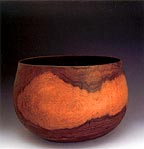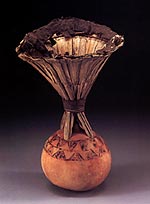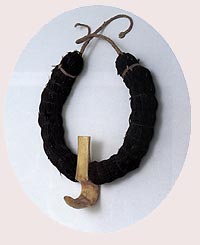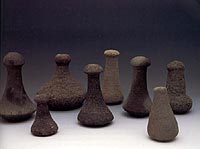
![]()
 |
|
|
 |
'Umeke Nui - Large Calabash This exceptionally large kou calabash is very rare. Kou wood was used because of its workability and fine grain. It did not impart a bad taste to food as did some of the other woods, such as koa. Wooden kou bowls were usually reserved for the ali'i (royalty), while the maka'ainana (commoners) used containers made of hollowed out gourds. The kou tree once was common along the shore, but was attacked in the 1850s by a nonnative insect that almost wiped out the species. Though not common, the tree can still be seen at certain shoreline locations. This calabash measures 13.5 inches high and 16.5 inches across the rim. |
 |
'Uli'uli - Rattle 'Uli'uli were used to accompany dancers of hula. The gourd or coconut shell container was filled with seeds and shaken to provide a beat to accompany the chant. This 'uli'uli has a gourd container with a handle of stiff, dried leaves (possibly from the Agavaceae family). Tapa lines the top and serves as a connecting band at the center. In a drawing by John Webber (an artist on Captain Cook's third voyage) of a dancer with a gourd rattle, the 'uli'uli is depicted with a feather fringe covering the handle. |
 |
Kiholo - Wooden Fishhook Hawaiians made large wooden hooks with bone points for shark fishing. Shark fishing was restricted to the ali'i (royalty). In this example, the bone point is not part of the original wooden hook, but fits for display. This wooden hook is 6.25 inches long. |
 |
Lei Niho Palaoa - Ivory Ornament Necklace This hook-shaped, whale-ivory ornament with a necklace of human hair was originally worn by the ali'i (royalty) as a symbol of rank and authority. A few of the human hair strands in the lei have broken, and the necklace bundle has been wrapped with black thread. The ornament pictured here is 4.5 inches long. Early ornaments were usually smaller, but with the whalers' ability to supply ivory in quantity, the ornaments became larger and were highly desired by the newcomers. They were made in great numbers for trade, as they were a unique representation of Hawaiian art. |
 |
Pohaku Ku'i Poi - Poi Pounders Hawaiian poi pounders came in many shapes and sizes. The root of the taro plant was a staple food for the early Hawaiians. It was pounded on a wooden board to a thick mash called pa'i'ai, which was later mixed with water and eaten with the fingers. The poi pounder in the center is 6.5 inches tall and the small one to the left is 4 inches tall. |
 |
Ki'i La'au - Wooden Image Images made of wood varied from a small figure with a pointed base, to a free-standing kalaipahoa (poison god) images with a back cavity, to the large temple images set around the heiau (temple). These wooden images were worshiped as a representation or embodiment of a god. Many hundreds if images were smashed and burned when Liholiho abolished the religious system in 1819. The images of wood that remain reveal that the ancient Hawaiian carvers were masterful woodworkers in their diverse and abstract portrayals of the gods. This superbly carved image was one of two female figures discovered in 1905 by David Forbes, William Wagner, and F.A. Haenisch. Two other wooden images and many other objects were found in a cave in Honokaa gulch just north of Kawaihae. |